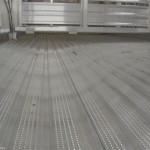How to Install Vinyl Plank Flooring on Stairs
Vinyl plank flooring represents a durable and aesthetically versatile option for many surfaces within a home or commercial building. Its water resistance, ease of maintenance, and variety of styles make it an increasingly popular choice. Extending this flooring to the staircase, however, requires specific techniques and considerations beyond simply laying planks on a flat surface. This article explains the process of installing vinyl plank flooring on stairs, covering essential preparation, cutting techniques, and securing methods.
A successful vinyl plank stair installation depends on meticulous planning and precise execution. Failing to properly prepare the stairs or using inappropriate adhesives can result in an unstable and unsightly installation. Conversely, a well-executed installation provides a durable, visually appealing transition between floors and enhances the overall aesthetic of the space.
Key Considerations Before Starting
Prior to commencing installation, several factors must be assessed. These considerations directly impact the materials required, the methodology employed, and the overall success of the project.
Stair Type and Condition: The existing stair construction significantly influences the installation process. Open stairs (those without risers) require a different approach than closed stairs. Similarly, the material of the existing stairs (wood, concrete, etc.) dictates the appropriate adhesives and fastening methods. The condition of the stairs is also crucial. Any loose boards, uneven surfaces, or structural issues must be addressed before proceeding. Repair any damage, fill gaps with wood filler, and ensure the stair treads and risers are structurally sound. Leveling compound might be necessary to correct significant unevenness.
Vinyl Plank Selection: Choosing the right vinyl plank is paramount. Consider the thickness of the planks; thicker planks generally provide better durability and impact resistance, which is important for stairs. The wear layer, the protective top layer of the plank, should be sufficiently durable to withstand the heavy foot traffic common on stairs. Also, select planks with a suitable slip resistance rating to minimize the risk of falls. Ensure that the chosen planks are compatible with the adhesive selected for the project.
Measuring and Planning: Accurate measurements are essential for minimizing waste and ensuring a professional finish. Measure the width and depth of each stair tread, as well as the height of each riser. Note any variations in these measurements, as stairs are often not perfectly uniform. Create a cutting plan to optimize material usage and minimize seams. Consider the direction of the planks and how they will align from one stair to the next. A detailed plan helps to avoid costly mistakes and ensures a cohesive aesthetic.
Preparing the Stairs for Vinyl Plank Installation
Proper preparation is the foundation for a long-lasting and visually appealing installation. This involves cleaning, leveling, and potentially adding underlayment.
Cleaning and Surface Preparation: Thoroughly clean the stairs to remove any dirt, dust, grease, or debris. A vacuum cleaner is effective for removing loose particles, followed by a damp cloth and a mild detergent. Ensure the stairs are completely dry before proceeding. Sanding the surface of the existing stairs can create a better bonding surface for the adhesive, especially if the stairs have a glossy finish. Remove any existing carpet, adhesive residue, or staples.
Leveling and Repairing Imperfections: Unevenness in the stair treads or risers can create problems during installation and compromise the integrity of the finished product. Use a leveling compound to fill in low spots and create a smooth, even surface. Allow the leveling compound to dry completely according to the manufacturer’s instructions. Use wood filler to repair any cracks or holes in the wood. Sand the filled areas smooth once dry.
Underlayment (Optional but Recommended): While not always necessary, an underlayment can provide several benefits. It can help to absorb sound, improve cushioning, and provide a smoother surface for the vinyl planks. Choose an underlayment specifically designed for vinyl plank flooring. Cut the underlayment to fit each stair tread and riser, and secure it with staples or adhesive. Ensure the underlayment is properly adhered to prevent movement during installation.
Installing Vinyl Planks on Stair Treads and Risers
This stage requires precision cutting and careful application of adhesive to ensure a secure and professional finish.
Cutting the Planks: Using the measurements taken earlier, cut the vinyl planks to fit each stair tread and riser. A utility knife with a sharp blade is generally sufficient for cutting vinyl planks. For more intricate cuts or thicker planks, a saw (circular saw, jigsaw, or miter saw) may be necessary. Always cut slightly larger than the measured dimension and then trim to fit for a precise fit. Use a straightedge to guide the cuts and ensure clean, straight lines. For stairs with bullnoses (rounded edges), specialized stair nosing pieces are required. These pieces are typically pre-manufactured to match the vinyl plank flooring and provide a finished edge to the stair tread.
Applying Adhesive: Choose an adhesive that is specifically designed for vinyl plank flooring and compatible with the existing stair material. Apply the adhesive evenly to the stair tread or riser, following the manufacturer's instructions. Use a notched trowel to create ridges in the adhesive, which promote better bonding. Avoid applying too much adhesive, as this can cause the planks to slide or create a messy installation. Work in small sections to prevent the adhesive from drying out before the planks are installed.
Securing the Planks: Carefully position the cut vinyl plank on the stair tread or riser, ensuring it is aligned properly. Press firmly on the plank to ensure good contact with the adhesive. Use a rubber mallet to gently tap the plank into place, paying particular attention to the edges. For stair treads, install the stair nosing piece according to the manufacturer's instructions. This typically involves applying adhesive to the back of the nosing and pressing it firmly against the edge of the tread. Some stair nosings may also require screws or nails for added security. Allow the adhesive to cure completely according to the manufacturer's instructions before using the stairs. This typically takes 24-48 hours. During the curing period, avoid walking on the stairs to prevent the planks from shifting.
Dealing with Stair Nosing: Stair nosing is a critical component of a vinyl plank stair installation. It provides a finished edge to the stair tread, protects the edge from wear and tear, and improves safety by providing a non-slip surface. Several types of stair nosing are available, including those that match the vinyl plank flooring and those that are made of metal or other materials. Select a stair nosing that is appropriate for the type of vinyl plank flooring being used and the style of the staircase. The method of installing stair nosing varies depending on the type of nosing and the manufacturer's instructions. Some nosings are glued in place, while others are attached with screws or nails. Ensure the stair nosing is securely attached to the stair tread to prevent it from coming loose over time. A loose stair nosing can create a tripping hazard.
Finishing Touches: After the adhesive has cured, inspect the installation for any gaps or imperfections. Use color-matched caulk or sealant to fill in any gaps along the edges of the planks or around the stair nosing. Clean up any excess adhesive or caulk with a damp cloth. Install any necessary trim or molding along the baseboards to conceal the edges of the flooring and create a finished look. Vacuum or sweep the stairs to remove any remaining debris.

How To Install Vinyl Plank Flooring On Stairs In 6 Steps Inc

Vinyl Plank Flooring On Stairs Your Total Guide Floorings

How To Install Vinyl Plank Flooring On Stairs In 6 Steps Inc

How To Install Vinyl Plank Flooring On Stairs In 6 Steps Inc

Pros And Cons Of Installing Vinyl Flooring On Stairs

How To Install Vinyl Plank Flooring On Stairs Ready Diy

Luxury Vinyl Tile Seamless Upstairs And Downstairs Solution

How To Install Vinyl Plank Flooring On Stairs Step By Tutorial

Self Adhesive Vinyl Floor Planks On Staircase Installation

How To Install Laminate Flooring On Stairs Direct Wood
Related Posts








